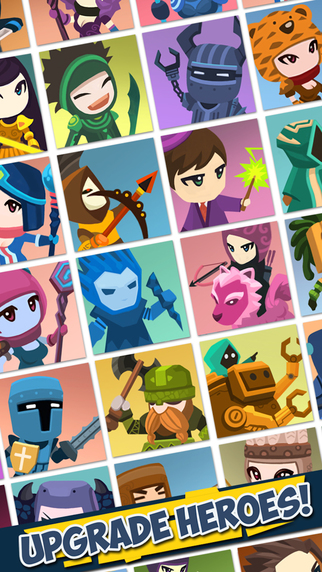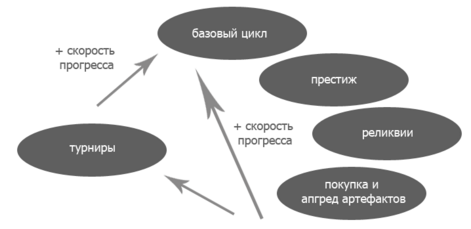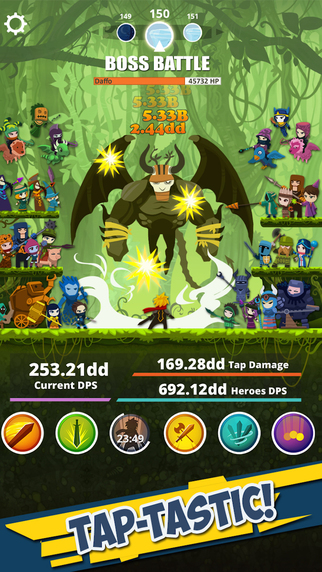Deconstruction: Tap Titans
Last December, Game Hive studio, known for the Beat the Boss series, released the Tap Titans role-playing clicker. There were a lot of interesting, unexpected solutions in the game, which we decided to talk about in this material.
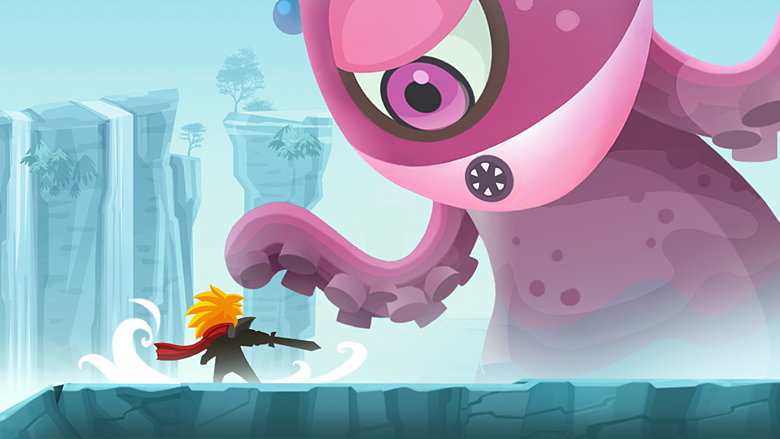
The project has now been downloaded more than 5 million times on the Android platform alone. On iOS, the game was in the box office gaming Top 10 in more than 30 countries.
The problems of clickers
The trouble with most clickers is that they get bored quickly. Their gameplay, as a rule, is built as follows: for one tap (click) you get one unit of soft game currency. The faster you tap (click) in the game, the faster your game money accumulates. When you accumulate a certain amount, you get the opportunity to buy a tool that automatically starts generating soft currency at the same time as you.
Already at this stage, tapanye as part of the gameplay loses its meaning. The user can now simply put the game aside to return to it in an hour or two to purchase another, much more expensive tool that will accelerate the production of soft currency.
Moreover, within the framework of the game, this really makes no sense, because the moment comes quite quickly when the tools begin to bring in much larger amounts of game currency per second than the user can accumulate in a significant period of time. In fact, from the moment of the first purchase, the gameplay begins to come down to the management of resource-generating tools. Managing the latter does not go beyond clicking on the “buy” button.
As a result, the game cycle usually looks something like this:

The cycle, as you can see, is very simple. And this is both its advantage and disadvantage at once. The obviousness of the system makes the games using it as accessible as possible to understand. At the same time, there is nothing here that can keep the player for a long time.
However, the low threshold of entry into the game when deciding on development often outweighs the theoretical problem of retention. Plus, you need to understand that the advantage of such games is not only a very low entry threshold, but also:
- trance (here – from the word trance) gameplay (watching the rapid increase in the number of cookies, gold coins or dollar bills has a hypnotic effect);
- high elasticity of the gaming session (you can spend from a few seconds to several hours on the game);
- relative cheapness and ease of development.
Therefore, it is not surprising that this genre continues to be popular with game developers. And we are sure that every team that has taken up the creation of a clicker, first of all, tries to solve the problem of retention.
However, in our opinion, at the moment, only the authors of the Tap Titans game really succeeded.
Basic gameplay
Game Hive has moved quite far away from the concept described just above.
There are really a lot of differences. Firstly, the user taps not “just like that”. He kills monsters. Their destruction, as a rule, does not happen from one tap – each opponent has its own healthbar. Only after killing the user receives a certain amount of money. Monsters themselves cannot attack.
The game is conditionally divided into levels. There are ten monsters on each level. Every tenth monster is a boss, every fifth boss is a super boss. From monster to monster, the enemies’ health increases, it becomes more and more difficult to kill them. This encourages you to spend the earned gold on:
- For the purchase and improvement of companions, fighters who strike monsters without the player’s participation (and who earn gold in his absence).
- For the purchase and improvement of active skills that the player activates in the game and which are valid for a strictly limited amount of time.
- To increase the force of your own blow (tap).
Approximately such a scheme is faced by a player who enters the game for the first time. And in his eyes , the game cycle may look something like this:
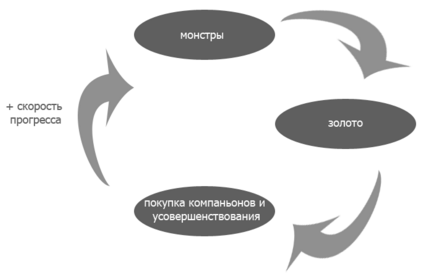
Already at this level, you can see that the basic cycle, in fact, receives a new link. Thanks to the introduction of a barrier between the action and directly receiving the reward, the game got an additional bottom, the developers had the opportunity to interact with the player within the genre in a wider range.
Solving the problem of “meaninglessness”
As we have already noted, one of the features of clickers is that in them the user click becomes meaningless quite quickly. The tools generate resources much faster than the user can summon. In some clickers, this problem is solved in a fairly obvious way: the player is given the opportunity to purchase not only a resource-generating tool for soft currency, but also one or another thing that significantly increases the tap property.
In Tap Titans, the solution is not the most elegant, perhaps, but it is still very interesting. The fact is that the two main characteristics in the game are:
- Impact Damage (damage from one user tap)
- Damage per second from companions (DPS – damage per second)
There is also a total damage per second, but it is, let’s say, for beauty. It is worth looking at only if you are currently furiously tapping on the screen and want to have an idea of how much damage you are doing to the enemy at the same time with your companions.
At first glance, these characteristics are not related. The damage from the blow increases in a separate column, the purchase of heroes takes place in a separate menu, but there are nuances.
Firstly, each companion, as well as the hero himself, can raise the level in the game – for gold. Each level cup of the companion gives an increase in attack per second. Plus, the first 10th, 25th, 50th and so on level of a particular companion allows the player to unlock a new companion ability. This can be an increase in the companion’s strike by several percent, an increase in total damage, and so on. Among these abilities there is one that affects the user’s own blow (more specifically, it is called in the game “+ 0.4% of DPS to damage from one user tap”).
In other words, if you have decently rocked your army of companions, then the tap strike will always be significant too.
The second point that has retained the important role of direct user interaction with opponents is active abilities. There are six of them in the game, each of them works only for a limited amount of time (from a few seconds), and after use it takes a long time to recover.
Their activation seriously speeds up the passage. Some of them work their time in automatic mode, but some makes sense only if the player taps (for example, it is not worth activating the chance of a critical hit + N if you are not going to tap).
The third key point is the bosses, which are given a strictly limited amount of time to defeat. If you failed, you stopped at the level, you can’t go any further. As a rule, bosses are killed hard in the game. Companions in most cases do not cope with them – it is necessary to use active abilities, one of which, by the way, accelerates their total DPS.
Digging deeper
All the things described above are the tip of the iceberg, which, let’s say, solves the basic problems of clickers. Game Hive, in turn, did not stop there. The new cycle simply gave them the opportunity to unobtrusively wind up additional features that made an honest midcore project out of the simplest and most transparent game.
What are these features?
Before proceeding to them, I would like to note the following point: the discovery of these features does not happen immediately. It may take from a few days to weeks before you find them at all.
And this is a very strong move on the part of the developers for two reasons.
Firstly, the new player is not disoriented by the situation with an overabundance of opportunities.
Secondly, inactive buttons stimulate interest, encourage the desire to activate them.
Plus, I would like to note that the game, in general, at the first moment appears to the player in a very ascetic quality. The hero has no companions (even an inactive button with the purchase of the first one), no active skills. The only thing he can do is tap. But after a while – in case of progress – you can get lost in the content. However, it is served so dosed that this, of course, does not happen.
Returning to the features.
There are three of them, and despite the fact that they do not become available immediately (you can easily kill a week to achieve them for the first time), they are all fundamentally important for the game and work in close conjunction with each other.
1. Artifacts. These are things that significantly enhance the characteristics of the hero and companions. There are a lot of them, but it is impossible to buy a specific artifact: the player simply spends a special game currency – relics (from the additional game cycle, which is described below) by pressing a button, and a random one is thrown to him.
2. Prestige. Prestige is the zeroing of the entire gameplay. After prestige, the player has only hard currency (crystals), artifacts and relics. All companions disappear, all active skills too. The player starts from the first level.
We will talk about the third point – tournaments – a little later, now we offer a little more detail on artifacts and prestige.
Why was it necessary to implement them?
In many role-playing shareware games, progress becomes very slow at a certain stage. As a rule, this may be evidence of the presence of a paywall. This is often the reason for the outflow of users who are not ready to pay or put up with the fact that they are growing very slowly in the game.
A similar slowdown in progress is also relevant for Tap Titans. That’s just paying real money is not the best way, because buying crystals (for which you can buy gold, which you can spend on a new companion) will provide a short-term acceleration, the acceleration margin will be minimal.
A much more effective way to increase dynamics is prestige.
Why?
The fact is that at the moment of prestige, the player receives relics. Their number depends on the level of the hero, how far the hero has gone and also for the full team (which is discussed below).
Recall that relics, like artifacts, are preserved, and artifacts give a significant increase in characteristics.
As a result, after buying artifacts, the hero begins to grow several times faster. And if, for example, you can go up to a certain level without artefacts for a week or two, then after gaining the first few pieces, the same level is quietly reached in a day or two.
Thus, the user, in fact, determines the dynamics of the game himself.
In order not to abuse prestige, access to it is not given immediately. Plus, it is always more profitable for the player to delay its use as much as possible, because the further the player has gone, the more relics he will receive.
And here we come back to the tournaments, which become available only after the player exercises prestige for the first time.
3. Tournaments are a competition for the speed of passing levels with other players. In case of participation in it, prestige occurs. In other words, all participants reset their progress to participate in it (and, of course, get relics for it). It is clear that the more artifacts you have, and the more pumped they are (yes, they can also be improved, only this is done exclusively for relics), the faster you rise in the top. For a high place in the top at the end of the tournament, they give weapons for companions, crystals and relics.
Weapons for companions cannot be called a very important component, but it fits perfectly within the general cycle, which is described below. Companion weapons give a significant (from 50%) increase in the strength of companions.
In fact, artifacts and prestige work, first of all, to preserve the dynamics of the game, as well as the tournament, which is also an important component in terms of motivation.
What is meant by a motivational plan?
It’s very simple. The player’s desire to take a high position in the top encourages him – motivates him – to play constantly, to play a lot, to make prestige many times, to receive relics, to buy artifacts and … as a result, to be where he wants.
In general, the second general game cycle has now been described in general terms:
Monetization
One of the variables affecting the number of relics obtained during prestige is the “full team”. What does this mean?
The fact is that from a certain level (to which you still have to try to reach), bosses can kill (disable for several hours) one of the available companions. If this happens, it is better not to carry out prestige, since the “full team” variable makes the most significant contribution in terms of relics.
If a player wants to take part in the tournament, for him the loss of a companion is like death, since he will not receive the desired relics. The only way to solve the problem is to revive the companion for hard game currency.
This is a very soft and at the same time effective way to monetize some users. To the credit of the developers, bosses rarely kill.
Another stimulating thing for purchases and for making prestige is “Character customization”. In fact, this is an opportunity to hang new clothes on your hero, which will seriously improve his characteristics. Access to things is opened in two cases. Or when committing a certain number of prestige (for example, have you committed 10 prestige? great, here’s an opportunity for you to wear a scarf that increases the critical crown), or for hard currency.
As you probably have already noticed, Tap Titans, in general, tends to give players an alternative in the form of prestige. If traditional free-to-play projects in the case of paywall, as a rule, do not give a choice (pay or suffer), then the creation of Game Hive says: start over or pay. At the same time, the second way is not the fact that it is a winning one.
If we talk in more detail about monetization, then we would single out three main monetization funnels:
- slowing down progress caused by the appearance of enemies with a very long life span and not giving enough gold for the victory over themselves to buy a new powerful companion;
- buying boosters (one of the boosters is just gold, the others are the possibilities of instant death of a strong monster, a shield from bosses, instant refilling of active skills, and so on);
- purchase of custom items for the character.
Actually, everything. As you can see, none of the funnels touch the cornerstone of the game – relics.
Content
Another point to focus on is the solution to the problem of quickly eaten content. It is clear that this problem was partly removed by prestige, which makes you constantly roll back to the very beginning, not reaching the maximum. And, by the way, without prestige, you really can’t get the maximum level. More precisely, it is probably possible in theory, but it will take a very long time. And this is a beautiful solution. Moreover, the developers repeated the story of prestige in the same game twice, when they made the companions reset their skills at the thousandth level.
It looks something like this: the companion reaches the thousandth level. At this point, most likely, the force of his blow is already insignificant. At the same time, all the skills work. If the user decides to reset the companion’s skills, then the latter becomes very strong, but at the same time it has to be pumped from the very beginning – and this is expensive, because after receiving a new status – a golden frame, he begins to demand steadily more for the upgrade.
Conclusion
Give Hive turned out to be an excellent project, which, thanks to the introduction of a number of new mechanics into the seemingly banal gameplay, easily changed the target audience, usually inherent in games of this genre.
